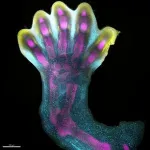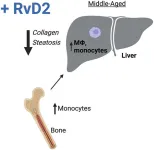(Press-News.org) Human fingers and toes do not grow outward; instead, they form from within a larger foundational bud, as intervening cells recede to reveal the digits beneath. This is among many processes captured for the first time as scientists unveil a spatial cell atlas of the entire developing human limb, resolved in space and time.
Researchers at the Wellcome Sanger Institute, Sun Yat-sen University, EMBL’s European Bioinformatics Institute and collaborators applied cutting-edge single-cell and spatial technologies to create an atlas characterising the cellular landscape of the early human limb, pinpointing the exact location of cells.
This study is part of the international Human Cell Atlas initiative to map every cell type in the human body1, to transform understanding of health and disease.
The atlas, published today (6 December) in Nature, provides an openly available resource that captures the intricate processes governing the limbs’ rapid development during the early stages of limb formation2.
The atlas also uncovers new links between developmental cells and some congenital limb syndromes, such as short fingers and extra digits.
Limbs are known to initially emerge as undifferentiated cell pouches on the sides of the body, without a specific shape or function. However after 8 weeks of development, they are well differentiated, anatomically complex and immediately recognisable as limbs, complete with fingers and toes. This requires a very rapid and precise orchestration of cells. Any small disturbances to this process can have a downstream effect, which is why variations in the limbs are among the most frequently reported syndromes at birth, affecting approximately one in 500 births globally3.
While limb development has been extensively studied in mouse and chick models, the extent to which they mirror the human situation remained unclear. However, advances in technology now enable researchers to explore the early stages of human limb formation.
In this new study, scientists from the Wellcome Sanger Institute, Sun Yat-sen University, and their collaborators analysed tissues between 5 and 9 weeks of development. This allowed them to trace specific gene expression programs, activated at certain times and in specific areas, which shape the forming limbs.
Special staining of the tissue revealed clearly how cell populations differentially arrange themselves into patterns of the forming digits4.
As part of the study, researchers demonstrated that certain gene patterns have implications for how the hands and feet form, identifying certain genes, which when disrupted, are associated with specific limb syndromes like brachydactyly - short fingers - and polysyndactyly - extra fingers or toes.
The team were also able to confirm that many aspects of limb development are shared between humans and mice.
Overall, these findings not only provide an in-depth characterisation of limb development in humans but also critical insights that could impact the diagnosis and treatment of congenital limb syndromes.
Professor Hongbo Zhang, senior author of the study from Sun Yat-sen University, Guangzhou, said: “Decades of studying model organisms established the basis for our understanding of vertebrate limb development. However, characterising this in humans has been elusive until now, and we couldn't assume the relevance of mouse models for human development. What we reveal is a highly complex and precisely regulated process. It is like watching a sculptor at work, chiselling away at a block of marble to reveal a masterpiece. In this case, nature is the sculptor, and the result is the incredible complexity of our fingers and toes.”
Dr Sarah Teichmann, senior author of the study from the Wellcome Sanger Institute, and co-founder of the Human Cell Atlas, said: “For the first time, we have been able to capture the remarkable process of limb development down to single cell resolution in space and time. Our work in the Human Cell Atlas is deepening our understanding of how anatomically complex structures form, helping us uncover the genetic and cellular processes behind healthy human development, with many implications for research and healthcare. For instance, we discovered novel roles of key genes MSC and PITX1 that may regulate muscle stem cells. This could offer potential for treating muscle-related disorders or injuries.”
ENDS
Contact details:
Jelena Pupavac
Press Office
Wellcome Sanger Institute
Cambridge, CB10 1SA
Email: press.office@sanger.ac.uk
Notes to Editors:
1. This study is part of the Human Cell Atlas (HCA), an international collaborative consortium which is creating comprehensive reference maps of all human cells—the fundamental units of life—as a basis for understanding human health and for diagnosing, monitoring, and treating disease. The HCA is likely to impact every aspect of biology and medicine, propelling translational discoveries and applications and ultimately leading to a new era of precision medicine.
The HCA was co-founded in 2016 by Dr Sarah Teichmann at the Wellcome Sanger Institute (UK) and Dr Aviv Regev, then at the Broad Institute of MIT and Harvard (USA). A truly global initiative, there are now more than 3,100 HCA members, from 98 countries around the world. https://www.humancellatlas.org
2. The researchers analysed human embryonic limb tissues between weeks 5 to 9 post-conception, provided by Addenbrooke’s hospital Cambridge, United Kingdom and the Women and Children’s Medical Centre, Guangzhou, China.
3. https://www.ncbi.nlm.nih.gov/pmc/articles/PMC1571054/
4. Video depicts gene expression clusters during limb development through spatial transcriptomic profiles and in situ staining of the tissue: This video shows the dynamic gene expression patterns of IRX1, SOX9 and MSX1, critical genes involved in limb formation. Their distinct distribution ensures the ‘chiselling’ process takes place. IRX1, crucial for digit formation, and SOX9, essential for skeletal development, converge into five distinct lengths within the developing limb, while MSX1, associated with undifferentiated cells, occupies the interdigital spaces between these clusters. At approximately week seven of development, molecules responsible for interdigital cell death are activated, leading to the elimination of cells in the intervening spaces. This orchestrated cell death finally unveils the well-defined shapes of fingers or toes.
Video credit: DOI: 10.1038/s41586-023-00000-0.
These data sets are available for interactive analysis at: https://limb-dev.cellgeni.sanger.ac.uk/
END
First map of human limb development reveals unexpected growth processes and explains syndromes found at birth
Scientists reveal unprecedented insights into human limb development, including the many intricate processes that govern their formation.
2023-12-06
ELSE PRESS RELEASES FROM THIS DATE:
Stanford Medicine-led study finds way to predict which of our organs will fail first
2023-12-06
Like any typical car or house or society, the pace at which parts of our bodies fall apart varies from part to part.
A study of 5,678 people, led by Stanford Medicine investigators, has shown that our organs age at different rates — and when an organ’s age is especially advanced in comparison with its counterpart in other people of the same age, the person carrying it is at heightened risk both for diseases associated with that organ and for dying.
According to the study, about 1 in every 5 reasonably ...
Bowtie resonators that build themselves bridge the gap between nanoscopic and macroscopic
2023-12-06
A central goal in quantum optics and photonics is to increase the strength of the interaction between light and matter to produce, e.g., better photodetectors or quantum light sources. The best way to do that is to use optical resonators that store light for a long time, making it interact more strongly with matter. If the resonator is also very small, such that light is squeezed into a tiny region of space, the interaction is enhanced even further. The ideal resonator would store light for a long time in a region at the size of a single atom.
Physicists and engineers have struggled for decades with how ...
Embargoed press release: Blood hormone levels key to identifying which post-menopausal women will benefit most from taking anastrozole to prevent breast cancer
2023-12-06
Research led by Queen Mary University of London’s Wolfson Institute of Population Health has found that hormone levels, measured through blood tests, are an important indicator of whether women will benefit from recently licensed medication for the prevention of breast cancer.
Aromatase inhibitors such as anastrozole are recommended by the National Institute of Clinical Care and Excellence (NICE) as an option for preventive therapy in post-menopausal women at high risk of breast cancer. Anastrozole (Arimidex) is now also licensed by the ...
MD Anderson Research Highlights: ASH 2023 Special Edition
2023-12-06
ABSTRACTS: 162, 309, 322, 364, 741, 774, 856, 983
SAN DIEGO ― The University of Texas MD Anderson Cancer Center’s Research Highlights showcases the latest breakthroughs in cancer care, research and prevention. These advances are made possible through seamless collaboration between MD Anderson’s world-leading clinicians and scientists, bringing discoveries from the lab to the clinic and back.
This special edition features oral presentations from the 2023 American Society of Hematology (ASH) Annual Meeting, describing the latest scientific and clinical breakthroughs for hematological cancers. In addition to these ...
EHR-based public health surveillance for chronic diseases
2023-12-06
INDIANAPOLIS – As hospitalizations due to chronic conditions increase across the United States, attention is focusing on using data collected in electronic health records (EHRs) by healthcare systems to enable public health departments to gain understanding of the incidence and prevalence of hypertension, diabetes, asthma, obesity and other chronic diseases with the ultimate goal of improving disease outcomes.
In the U.S., 90 percent of clinicians, medical laboratories, imaging centers and other providers use EHR systems, providing ample data on individuals with access to healthcare. However, access ...
Tucatinib plus trastuzumab emtansine may benefit patients with advanced or metastatic HER2-positive breast cancer
2023-12-06
SAN ANTONIO – A combination of two HER2-targeted drugs, tucatinib (Tukysa) and trastuzumab emtansine (Kadcyla, T-DM1), extended progression-free survival among patients with unresectable locally advanced or metastatic HER2-positive breast cancer, compared with T-DM1 alone, according to results from the HER2CLIMB-02 trial presented at the San Antonio Breast Cancer Symposium, held December 5-9, 2023.
T-DM1 is an antibody-drug conjugate comprised of trastuzumab (Herceptin) and the cytotoxic drug emtansine. It was approved for use ...
Neoadjuvant chemotherapy may help some breast cancer patients skip regional nodal irradiation
2023-12-06
SAN ANTONIO – For patients whose breast cancer converted from lymph node-positive to lymph node-negative disease after neoadjuvant chemotherapy, skipping adjuvant regional nodal irradiation (RNI) did not increase the risk of disease recurrence or death five years after surgery, according to results from the NRG Oncology/NSABP B-51/RTOG 1304 clinical trial presented at the San Antonio Breast Cancer Symposium, held December 5-9, 2023.
Patients who are diagnosed with breast cancer that has already spread to regional lymph nodes may receive neoadjuvant chemotherapy; in some cases, neoadjuvant therapy completely eradicates ...
Study: diverse college classrooms linked to better STEM learning outcomes for all students
2023-12-06
Washington, December 6, 2023—Students achieve better grades in college science, technology, engineering, and math (STEM) courses when those classrooms have higher numbers of underrepresented racial-minority and first-generation college students, according to new research released today. The findings were published in AERA Open, a peer-reviewed journal of the American Educational Research Association.
While this link holds true for all students, it is even stronger for students who are underrepresented racial minorities (URMs) and the first in their family to attend college. The authors found that in STEM courses ...
Repeated blast exposures may harm the brain health of military personnel
2023-12-06
The brains of special warfare community personnel repeatedly exposed to blasts show increased inflammation and structural changes compared with a control group, potentially increasing the risk of long-term, brain-related disease, according to a new study.
Researchers from the University of Virginia School of Medicine and Naval Medical Research Command (NMRC) led the study, which compared the brains of nine special operations personnel exposed to blasts with a control group of nine military service members with only minimal exposures to blasts. Participants’ brains were analyzed using sophisticated imaging techniques, combined with surveys ...
New findings reveal important insights into age-related nonresolving inflammation
2023-12-06
Philadelphia, December 6, 2023 – Aging is associated with chronic, nonresolving inflammation, or “inflammaging,” that can lead to tissue dysfunction. New findings reported in The American Journal of Pathology, published by Elsevier, reveal insights into the cellular programs and factors that promote the resolution of inflammation during aging. These findings may lead to the development of new strategies to limit age-related organ decline.
The resolution of inflammation is an active process that is governed by numerous factors, such as specialized ...
LAST 30 PRESS RELEASES:
S-species-stimulated deep reconstruction of ultra-homogeneous CuS nanosheets for efficient HMF electrooxidation
Mechanical and corrosion behavior of additively manufactured NiTi shape memory alloys
New discovery rewrites the rules of antigen presentation
Researchers achieve chain-length control of fatty acid biosynthesis in yeast
Water interactions in molecular sieve catalysis: Framework evolution and reaction modulation
Shark biology breakthrough: Study tracks tiger sharks to Maui mating hub
Mysterious iron ‘bar’ discovered in famous nebula
World-first tool reduces harmful engagement with AI-generated explicit images
Learning about public consensus on climate change does little to boost people’s support for action, study shows
Sylvester Cancer Tip Sheet for January 2026
The Global Ocean Ship-Based Hydrographic Investigations Program (GO-SHIP) receives the Ocean Observing Team Award
Elva Escobar Briones selected for The Oceanography Society Mentoring Award
Why a life-threatening sedative is being prescribed more often for seniors
Findings suggest that certain medications for Type 2 diabetes reduce risk of dementia
UC Riverside scientists win 2025 Buchalter Cosmology Prize
SETI Institute opens call for nominations for the 2026 Tarter Award
Novel theranostic model shows curative potential for gastric and pancreatic tumors
How beige fat keeps blood pressure in check
Fossils reveal ‘latitudinal traps’ that increased extinction risk for marine species
Review: The opportunities and risks of AI in mental health research and care
New map reveals features of Antarctic’s ice-covered landscape
Beige fat promotes healthy vascular function and blood pressure in mice
Chronic low-dose pesticide exposure reduces the life span of wild lake fish, China-based study shows
Tiny earthquakes reveal hidden faults under Northern California
Long-term pesticide exposure accelerates aging and shortens lifespan in fish
Professor Tae-Woo Lee's research group develops groundbreaking perovskite display technology demonstrating the highest efficiency and industry-level operational lifetime
The “broker” family helps tidy up the cell
Ecology: Mummified cheetahs discovery gives hope for species’ Arabic reintroduction
Researchers survey the ADHD coaching boom
Air pollution and cardiac remodeling and function in patients with breast cancer
[Press-News.org] First map of human limb development reveals unexpected growth processes and explains syndromes found at birthScientists reveal unprecedented insights into human limb development, including the many intricate processes that govern their formation.





